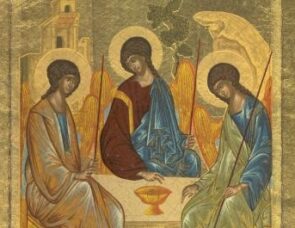Using a sacred Russian icon to explore what Christians believe about the Trinity.

Introduction
This classroom activity explores what Christians believe about the Trinity. It’s hard to picture God, but we can try to show what God is like. This lesson introduces pupils to the work of Icon painters from the Orthodox Christian tradition, who use all sorts of techniques to show the unshowable.
Preparation
You’ll need: a copy or copies of the Andrei Rublev ‘Holy Trinity’ Icon for display. Images of this icon can be downloaded from the web. An excellent resource for studying this further is Margaret Cooling’s ‘The Bible through Art’, (RMEP 2000).
Development
Before you show the children the icon, say that sometimes artists try to paint exactly what they see. And sometimes they try to paint what can’t be seen. This might look strange to us, if we’re expecting to see a picture like a photograph. Sometimes we need to be prepared to use our imagination and look beyond the strangeness to what the artist is trying to tell us about.
Show the children the icon without giving them its name and ask some of these questions:
What is this group of people doing?
How do you think they feel about each other?
What might they be saying to each other?
Look at their faces – what do you notice?
What colours are the clothes they’re wearing?
What can you make out in the background behind them?
What’s on the table between them?
Do these objects remind you of any stories?
If you drew a line round the three figures, what shape would it be?
What happens if you draw that shape in and out of the picture, round the back of the characters?
How does the picture make you feel?
What do you think the artist wants us to think about this group?
Who do you think the three people in this picture might be?
Notes
Explain (if you need to) that it’s a picture of the Trinity: Jesus is in the middle, with God the Father below the building on the left of the picture, and God the Holy Spirit on the right.
Background objects:
- The tree may represent the oaks at Mamre where God spoke to Abraham, or the tree of life in Genesis and Revelation.
- The mountain: many important events happened on mountains in the Bible – eg God giving Moses the Ten Commandments, or the Transfiguration.
- The building may be the heavenly city where God lives.
- The figures’ faces are identical, perhaps to show they’re the same person in three people – a great mystery!
- They all have blue on – a heavenly colour. Green means new life. Brown is for earthly or human things. Gold is for royalty
- The artist has composed the figures so that you can draw circles in both dimensions: for example a circle round the group in the picture, or a ‘flat’ circle that comes out of the picture and encompasses us the onlookers.
- The artist was trying to draw God – but he knew that’s impossible! We don’t know what God looks like! So he’s trying to show us something about what he believes about God – what God is like.
Now make a list together of all the things this artist is trying to tell us about what he thinks God is like.
For further development: compare this image with the contrasting Trinity by Fr.John Guiliani, images and explanations of which can also be found on the web. What is similar- and what is different?
Drawing what God's like
You’ll need: paints, crayons, felt tips, pastels etc, good quality paper
Ask the children: How would you draw God to show somebody who doesn’t know him what he is like?
Reflective prayer activity
In a circle, practise holding hands crossed across your chests and turning to face outwards without letting go hands.
(Begin facing inwards, not holding hands.)
Dear God, you are three people in one circle of love.
(Hold hands, as practised, with arms crossed across chests)
We are (20? 30?) people in a circle.
(Turn to face outwards without letting go hands)
Help us to welcome others into our community.
(Lift up arms together)
Amen

 Download
Download